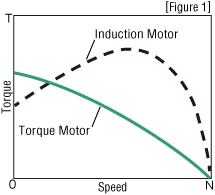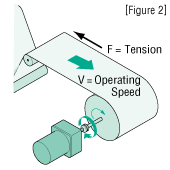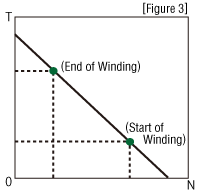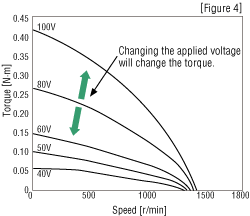What Kind of Motor is a Torque Motor?


-

Considering a winding application.
-

What is it, Vex?
-

Take a look at this. This is a product recommendation information sheet from a customer. They're looking for a motor that is suitable for a winding application, I'd like to introduce a torque motor. But when I was asked, "What kind of motor is a torque motor?" I couldn't come up with the right words...
-

Oh my, it seems like the characteristics of a torque motor are not quite clear. First, look at the torque motor's torque characteristic curve. (Refer to Figure 1)
Torque motors have a large starting torque and sloping characteristics that allow the motor to be used over the entire speed range, from maximum speed until it's locked.
-

I see. It's totally different from an induction motor.
-

That’s right. So why is this feature suitable for winding? Because winding equipment requires constant tension and constant speed. It's the same with a label-printing machine. Let's say you have an outfeed roller and a winding roller here. What happens to the diameter of the winding side as you wind it up more and more? What's the speed?
-

Hmm...the diameter will naturally increase. In this case, the winding amount will get bigger and bigger with each rotation, the winding speed will become faster and faster if the motor's rotation speed is the same. Also...the diameter gets larger as you get closer to the end of the winding, more rotational force (torque) is required, right?

-

Exactly! In order to keep the speed of the reel constant, you have to slow down the rotation speed as the diameter increases. And it needs to have the characteristic that the motor torque increases as the diameter increases.
In order to wind at a constant speed and tension, the motor must be able to adjust its "speed" and "torque" according to changes in the load. Look at this graph. This is an illustration of the characteristics required of a motor for winding work (refer to Figure 3). These characteristics are required at the beginning and end of winding. Don't you think it's similar to the characteristic curve of a torque motor that I just described?

Characteristics suitable for winding applications image →Torque motors have sloping characteristics, so similar characteristics can be obtained.
- -

You're right. They look similar. Okay, so that's why that curve "sloping characteristic" of torque motors is suitable for winding applications! Torque motors really are perfect for winding applications, aren’t they? But, Ms. Ori... I tried to calculate the required characteristics based on the customer's conditions, but they don't seem to fit well with these torque-speed characteristics.
-

You can change the torque characteristics by changing the applied voltage. By changing the voltage, the motor torque can be changed while maintaining the distinctive sloping characteristics of a torque motor (refer to Figure 4).
Incidentally, to change the applied voltage, you can use a commercially available voltage adjustment device.
-

I see! Well then, I will introduce torque motors and voltage adjustment devices to the customer right away.
-

Hold on. Then there's a new products ''TM Series'' of torque motor and power controller packages. The TM Series power controllers are very compact, and the torque can be easily set with the potentiometer. You can switch between internal and external potentiometers for 2 different torque settings, and you can also control settings with external DC voltage. The series also has a thermal protector open detection function, so if the motor temperature rises too high and the thermal function is activated, it can be output as an external alarm. It's secure.
-

The TM Series looks simple and great! All right, I'll take a look at the features of the TM Series and introduce to the customer.
-

That's a good spirit. But it wasn't able to describe it well, so let's start with a good review of the torque motor itself. A good salesman approaches the customer fully prepared.
-

Yes. I'll work hard every day to become an excellent salesman.